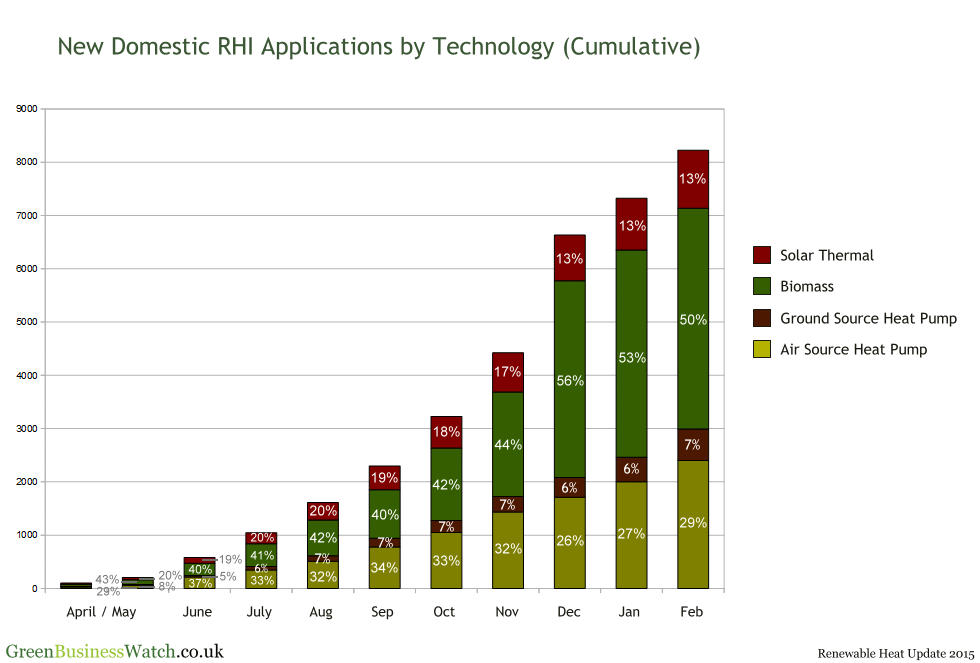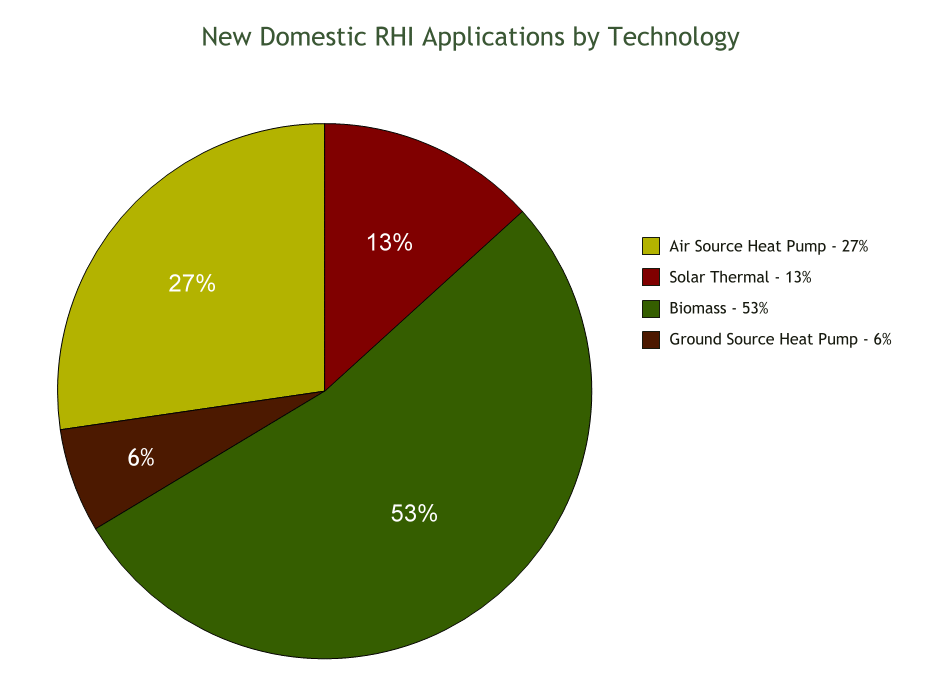UK Domestic Renewable Heat Update – February 2015
The latest data available for the Domestic Renewable Heat Incentive covers the period from the launch of the scheme on April 9th 2014 to the end of January 2015. The Domestic Renewable Heat Incentive (Domestic RHI) is a UK Government scheme to encourage the use of renewable heating technologies. Under the scheme, householders receive quarterly payments for a period of 7 years based on the amount of renewable heat their system produces. Figures from the scheme show the rate of growth for UK renewable heat installations slowing in January. This is largely as a result of a sharp peak in biomass installs in December 2014 as customers and installers rushed to complete installations before a biomass tariff drop at the beginning of January.
Key Points From January 2015
Legacy Applications Continue to Dominate
The Domestic RHI has had 24,882 applications. Legacy applications account for 70.57% (17,558) of applications to date. Only 29.43% (7,324) of applications are for “new” installations, ie those that took place since the launch of the scheme. It is new applications that give us an indication of current activity in the renewable heat market.
Rate of Growth Slows with Biomass Installations Falling Dramatically
The number of installations applied for under the Domestic RHI increased month on month for the 8 months from the start of the scheme to December 2014. January 2015 represents the first month where new installations were lower than the previous months. In fact, new installations fell dramatically.
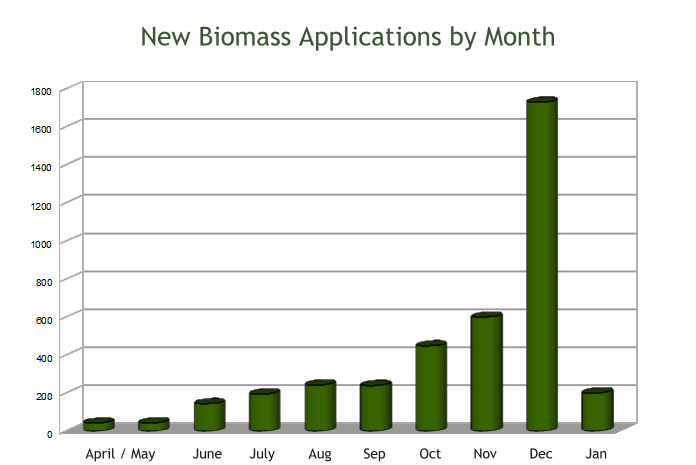 We indicated in last month’s update that the huge growth in biomass for December could well be caused by a rush to get applications submitted before the tariff drop for biomass on January 1 2015. This looks to have been the case and domestic biomass had a big hangover month in January with only 201 applications for new biomass installations. There is also probably an element of seasonality at play. Projects take time from initial enquiries to completion and less people will start that process in the run up to Christmas, making it likely that there are less completions in January.
We indicated in last month’s update that the huge growth in biomass for December could well be caused by a rush to get applications submitted before the tariff drop for biomass on January 1 2015. This looks to have been the case and domestic biomass had a big hangover month in January with only 201 applications for new biomass installations. There is also probably an element of seasonality at play. Projects take time from initial enquiries to completion and less people will start that process in the run up to Christmas, making it likely that there are less completions in January.
Ground Source Continues to Build Slowly
 Ground source heat pumps started from a very low base and have grown slowly and consistently since the launch of the scheme. Ground source tends to have a slightly longer lead time than the other technologies so uptake under the Domestic RHI has taken longer to filter through as completed installations.
Ground source heat pumps started from a very low base and have grown slowly and consistently since the launch of the scheme. Ground source tends to have a slightly longer lead time than the other technologies so uptake under the Domestic RHI has taken longer to filter through as completed installations.
Air Source Heat Pumps Return to Growth
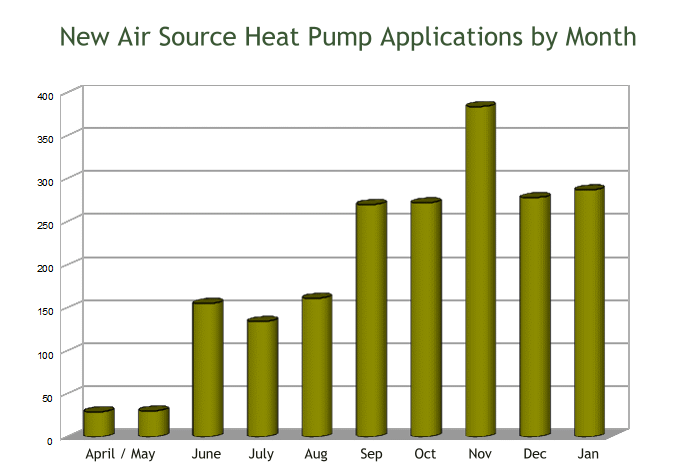 New air source heat pump installations went up slightly in January. Given the likely seasonality factors at play this is good news.
New air source heat pump installations went up slightly in January. Given the likely seasonality factors at play this is good news.
Solar Thermal Installation Numbers Fall for 4th Month in a Row
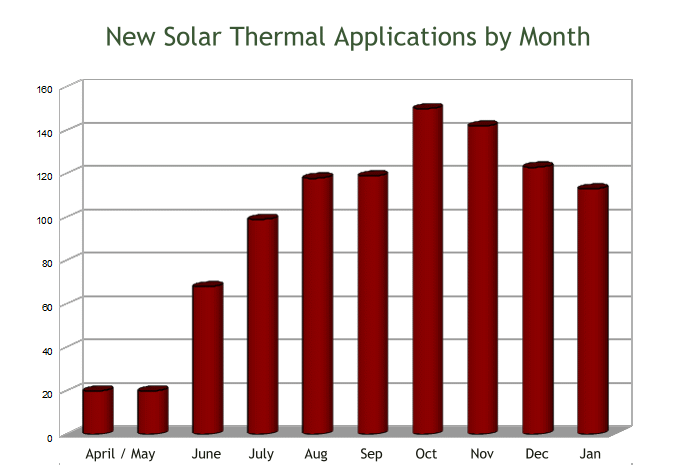 The number of new solar thermal installations went down in January for the 4th month in a row. It will be interesting to see how installation numbers hold up in the coming months.
The number of new solar thermal installations went down in January for the 4th month in a row. It will be interesting to see how installation numbers hold up in the coming months.
New Applications by Installed Technology
New applications are for systems installed since the launch of the scheme on 9th April 2014.
| Technology | Applications | Accreditations | ||
|---|---|---|---|---|
| Number | % | Number | % | |
| Air Source Heat Pump | 2,000 | 27% | 1,556 | 25% |
| Ground Source Heat Pump | 461 | 6% | 341 | 5% |
| Biomass | 3,891 | 53% | 3,501 | 56% |
| Solar Thermal | 972 | 13% | 846 | 14% |
| Total | 7,324 | 100% | 6,244 | 100% |
Total Applications by Installed Technology
Total applications include both new applications and legacy applications.
| Technology | Applications | Accreditations | ||
|---|---|---|---|---|
| Number | % | Number | % | |
| Air Source Heat Pump | 9,066 | 36% | 7,817 | 36% |
| Ground Source Heat Pump | 3,994 | 16% | 3,380 | 15% |
| Biomass | 6,718 | 27% | 6,171 | 28% |
| Solar Thermal | 5,104 | 21% | 4,564 | 21% |
| Total | 24,882 | 100% | 21,932 | 100% |
Our Domestic Renewable Heat Updates page is updated monthly with the latest figures, reports and graphs on domestic renewable heat activity in the UK and numbers from the Domestic RHI.
If you would like to find out more about the Domestic RHI, you might find our Domestic RHI Guide useful.
A Note on Graphs Images and Figures Used in this Update
This update is based on statistics released by DECC on the uptake of the Domestic RHI. If you wish to use graphs etc. from this update, you are free to do so and do not need specific permission. We would ask that you credit the source of the images by linking to this update.


